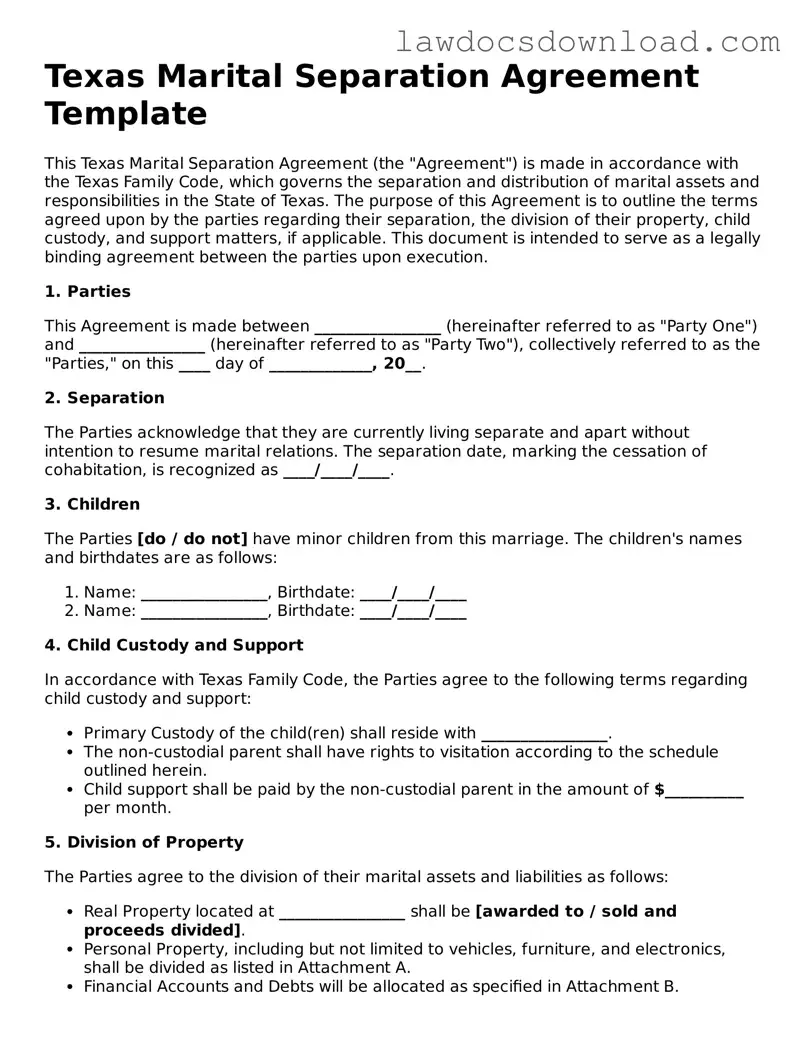Texas Marital Separation Agreement Template
This Texas Marital Separation Agreement (the "Agreement") is made in accordance with the Texas Family Code, which governs the separation and distribution of marital assets and responsibilities in the State of Texas. The purpose of this Agreement is to outline the terms agreed upon by the parties regarding their separation, the division of their property, child custody, and support matters, if applicable. This document is intended to serve as a legally binding agreement between the parties upon execution.
1. Parties
This Agreement is made between ________________ (hereinafter referred to as "Party One") and ________________ (hereinafter referred to as "Party Two"), collectively referred to as the "Parties," on this ____ day of _____________, 20__.
2. Separation
The Parties acknowledge that they are currently living separate and apart without intention to resume marital relations. The separation date, marking the cessation of cohabitation, is recognized as ____/____/____.
3. Children
The Parties [do / do not] have minor children from this marriage. The children's names and birthdates are as follows:
- Name: ________________, Birthdate: ____/____/____
- Name: ________________, Birthdate: ____/____/____
4. Child Custody and Support
In accordance with Texas Family Code, the Parties agree to the following terms regarding child custody and support:
- Primary Custody of the child(ren) shall reside with ________________.
- The non-custodial parent shall have rights to visitation according to the schedule outlined herein.
- Child support shall be paid by the non-custodial parent in the amount of $__________ per month.
5. Division of Property
The Parties agree to the division of their marital assets and liabilities as follows:
- Real Property located at ________________ shall be [awarded to / sold and proceeds divided].
- Personal Property, including but not limited to vehicles, furniture, and electronics, shall be divided as listed in Attachment A.
- Financial Accounts and Debts will be allocated as specified in Attachment B.
6. Alimony/Spousal Support
Following the guidelines of the Texas Family Code, the Parties [agree / do not agree] to alimony or spousal support. If agreed, the terms are as follows:
- The amount of spousal support to be paid from ________________ to ________________ is $__________ per month.
- Duration of the spousal support is for a period of ____ years/months.
7. Entire Agreement
This Agreement constitutes the complete agreement between the Parties concerning their separation and supersedes any prior or contemporaneous agreements, whether oral or written. Any amendments to this Agreement must be in writing and signed by both Parties.
8. Governing Law
This Agreement shall be governed by and construed in accordance with the laws of the State of Texas.
IN WITNESS WHEREOF, the Parties have executed this Agreement on the date first above written.
Party One Signature: ____________________________________
Party Two Signature: ____________________________________
Date: _________________________
